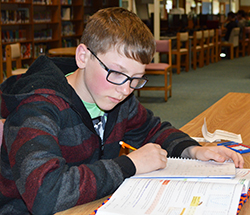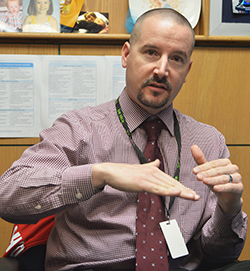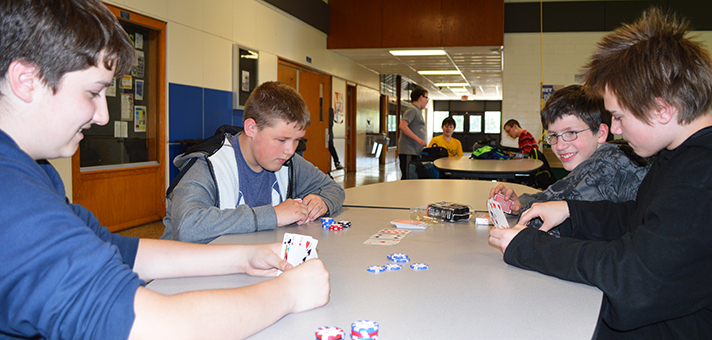A shakeup of the school day at Sparta Middle School has opened up new opportunities for students to reap rewards for good behavior and receive help when they’re falling behind. Meanwhile, their teachers gain added time for collaboration.
The change provides students with two pathways for a once-a-week period: earned activity time for positive behavior, or academic support if their grades are low. This time replaces a seminar period in students’ schedules.
Students from every grade level who earn activity time head to the cafeteria to play games or catch up on homework, or to the gymnasium to shoot hoops or play dodge ball, supervised by dean of students Clint McDowell. The academic support center is held in the media center, where Principal Brad Wood supervises students needing extra help.
Good behavior awards them the opportunity to socialize with other students through games and activities or, if they prefer, study.

A Chance for Extra Help
For sixth-grader Mackenzie Klein, her first year in the building has been smoothed by socializing with students in other grades at the center.
“I’ve made friends with older groups of people,” Mackenzie said, noting she doesn’t get to spend class time with them. “It’s a chance to sit down with them: ‘Hey, how are you doing?'”
Eighth-grader Jacob Spencer said his math grades have improved lately thanks to his time spent in the academic support center. He’s also earned activity time to blow off pent-up energy.
“With earned activity time, we have a chance to get out a bunch of energy that we’ve gotten over the day, since we don’t get recess, but if you need help you can still get it,” Jacob said. “If I need help I will take the chance to get it.”
In the previous model, students had a seminar period twice a week, and had to seek out academic support themselves rather than receiving instruction from teachers.
“What’sreally changed is that seminar (period) was very student-driven,” said Wood. “Students had to take initiative. Now teachers sign up kids, direct them where to go when they need help. We hope there are fewer kids falling between the cracks.”

More Teacher Planning Time
The new structure is the result of months of school improvement team planning. That included a professional development trip to Adlai E. Stevenson High School outside Chicago, to observe how the district utilized its time to improve student achievement while allowing teachers more time to collaborate.
The schedule at Sparta now allows teachers 200 extra minutes each week to work together, to streamline curriculum without cutting into before- and after-school time. It also adds the equivalent of about four days of instructional time to the school year.
Social studies teacher Keith Tidey said the department has gotten into a groove of regularly discussing how to better prepare and transition students from grade to grade. Tests and quizzes, assignments and language are better aligned, he said, and teachers across grade levels have noticed improvement.

Earned activity time has also geared students toward a common goal: celebrating when no one lands on the list for the academic support center, he added. This means no students’ grades are failing, no one is behind on assignments and no one has to receive tutoring.
“It’s a motivator,” Tidey said. “They want to hang out with their friends; they want to do their structured support. They all cheer, ‘No one’s on the list! Woo-hoo!'”
‘Structured, but It’s Choice’
While Wood’s and McDowell’s jobs usually involve discipline, Wood said this setup allows for positive interactions with students.
“As the principal, it gives me an opportunity to connect with the kids who struggle on a regular basis,” Wood said. “Clint gets to connect with students who are being successful, making good choices, and affirms those choices by leading that time.
“Sometimes in our positions we often deal with the challenges that arise, but this is a way for us to be directly involved in some positive stuff.”
It’s up to teachers to award students earned activity time or sign them up for academic support if their grade is below 70 percent. Wood said the direction from teachers still allows students control over their actions.

“This is a healthy amount of choice,” Wood said. “It’s supervised, it’s structured, but it’s choice. They aren’t pointed in any one direction, (but are) given the opportunity to take initiative and get help if they need it.
“Not all learning takes place in class. Kids can learn that choices and how they prioritize can have positive outcomes, or it can have outcomes that they may not like.”
Academics aren’t the whole story for students, McDowell said. Social time, especially for those who recently left behind elementary-level recess, can be valuable.
“So many of our kids socialize through a screen. Now they have an opportunity to sit down and play a game or have a conversation or shoot baskets.
“Even the kids who have a tougher time socially still have that each week,” he added. “That incentive to want to do that is always there for them.”










